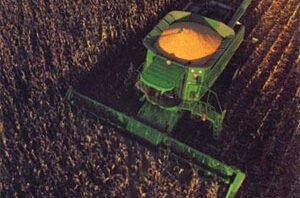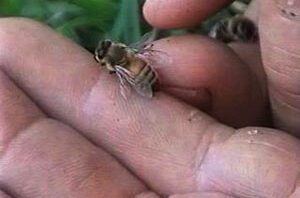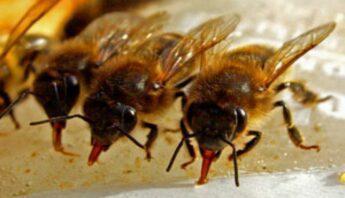Paul Towers, Pesticide Action Network
ptowers@panna.org, 916.216.1082 cell
May 15, 2012
Farmers Press for Access to Bee-Friendly Corn Seeds
Farmers struggle to find alternatives to neonicotinoid-treated seeds as pesticides are linked to bee die-offs
Minneapolis, MN – On the heels of Thursday’s NBC Nightly News special entitled “Bee deaths linked to pesticides”, and recent reports of large bee kills in Ohio, farmers from across the Midwest are calling on federal officials to provide greater access to seeds without pesticide treatments. The request comes as scientists and beekeepers highlight the nearly pervasive use of neonicotinoids as seed treatments on corn as a critical factor in recent bee die-offs, including colony collapse disorder. Beekeepers from Minnesota to Ohio to Canada report large losses after their hives forage near treated cornfields. Scientists from Purdue University and a multi-year series of studies from Italy point to toxic dust, or neonicotinoid-contaminated powder from recently planted corn fields as key pesticide exposure pathways for bees.
"Farmers want to be good stewards and neighbors by purchasing seeds and growing corn that supports healthy honey bees and successful beekeepers," said Doug Voss, a Minnesota corn farmer who also keeps bee hives. We have a genuine concern with the majority of corn produced having properties that can negatively impact honeybees."
At least 94% of the nation’s 92 million acres of corn will be treated with one of two neonicotinoids, both manufactured by Bayer and greater than the total size of the state of Minnesota, Nebraska or the Dakotas (combined). In addition, these are among the largest honey producing states in the country, housing some of the nation’s largest pollination services businesses. On average, USDA reports that beekeepers have been losing over 30% of their honey bee colonies each year since 2006.
“Honey bees are caught in the crossfire,” said Steve Ellis, owner of Old Mill Honey Co. and the subject of the recent NBC Nightly News piece. “Honey bees, like mine, are subjected to increasingly toxic load of pesticides in corn fields. It’s time to rethink the use of neonicotinoids and provide farmers with better options that allow all of us to prosper.”
Neonicotinoids are a relatively new class of systemic, neurotoxic pesticides that are known to be particularly toxic to honeybees and have rapidly taken over the global insecticide market since their introduction in the 1990s. Neonicotinoids (like imidacloprid and its successor product clothianidin) are used as seed treatments in hundreds of crops from corn to almonds. These products can persist for years in the soil, and, as systemics, permeate the plants to which they are applied to be expressed as pollen, nectar and guttation droplets (water exuded from plants). Honeybee exposure to this class of pesticides is widespread and in the U.S. the rate of seed treatment with clothianidin increased five-fold (0.25 > 1.25 mg/seed) around the same time that CCD symptoms were first reported in the U.S. Bees rely on corn pollen as a key protein source and are known to collect and bring back to the hive contaminated pollen.
Seeds treated with these insecticides are sticky and don’t readily come out of common corn planting machines; so farmers often use talcum powder to help the seeds move more easily through the machine and into the ground. The talcum powder, mixed with the loose pesticide creates a powerful pesticide dust that can directly coat and kill bees flying over freshly sown fields, and travel on wind to contaminate nearby untreated fields, creating even greater potential exposure for bees.
"We know that these insecticides are highly toxic to bees; we found them in each sample of dead and dying bees," said Christian Krupke, PhD, associate professor of entomology at Purdue University and author of several recent bee studies. "Whatever was on the seed was being exhausted into the environment. This material is so concentrated that even small amounts landing on flowering plants around a field can kill foragers or be transported to the hive in contaminated pollen. This might be why we found these insecticides in pollen that the bees had collected and brought back to their hives."
Despite their best intentions, including those involved in the cutting-edge Working Landscapes Certificate program, farmers have struggled to find alternatives to neonicotinoid treated seeds. As conventional growers began to transition away from pesticide and herbicide treatments, they discovered that sourcing corn seed that wasn’t treated with neonicotinoids was the most difficult challenge of all.
“Corn farmers engaged in Working Landscapes are concerned about pollinators, and are becoming increasingly aware of the impacts of neonicotinoids on bee populations, said Jim Kleinschmit, Rural Communities Program Director at IATP. “The problem is that there isn't much supply of bee-friendly seeds. The fact is, you just can’t find high-yield, untreated corn seed anymore because of seed industry consolidation.”
The science around the impacts of neonicotinoid products on bees continues to grow as federal policymakers are slow to respond. Pesticides and Honey Bees: State of the Science documents evidence that pesticides are a key factor in explaining honey bee declines, both directly and in tandem with two leading co-factors, pathogens and poor nutrition. These studies, in U.S. and in Europe, have shown that small amounts of neonicotinoids—both alone and in combination with other pesticides—can cause impaired communication, disorientation, decreased longevity, suppressed immunity and disruption of brood cycles in honeybees.
“In the last few months alone, several published studies have strengthened the connection between bee die-offs and neonicotinoid pesticides,” said Heather Pilatic, PhD, Co-Director of Pesticide Action Network and author of the recent Pesticides and Honey Bees: State of the Science. “Policymakers should consider this weight of evidence and take immediate steps to protect pollinators from pesticides.”
###
Available for Interviews:
Jim Kleinschmit, Rural Communities Program Director at Institute for Agriculture and Trade Policy. Can connect to Nebraska corn growers: (612) 870-3430.
Steve Ellis, beekeeper and owner of Old Mill Honey Co., based in Minnesota: (651) 357-8280.
Bret Adee, owner of Adee Honey Farms, a corn grower and beekeeper in South Dakota: (661) 303-5031.
Heather Pilatic, PhD, Co-Director at Pesticide Action Network and author of Pesticides and Honey Bees: State of the Science: hpilatic@panna.org.
Doug Voss, a corn grower who also keeps bees near Paynesville, Minnesota: (763) 213-9978.







